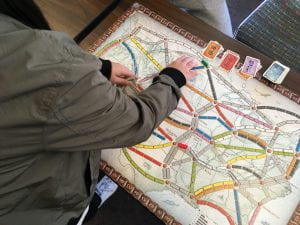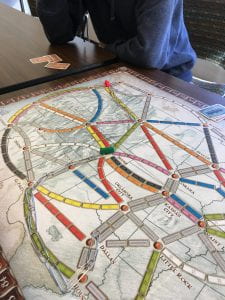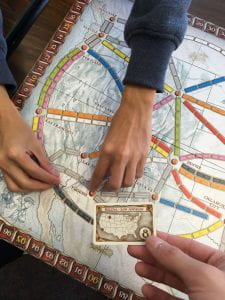So for my Appropriated Game, I wanted to do something that took a traditional game, and transformed it (with mostly the same pieces) into a whole new game experience. I wanted to see how the game pieces could be used differently, and how to apply a new spin on something made entirely for one purpose.
I started going through all the games that I had available to me. I ruled out most board games that had cards with specific lines of rules text on them (Dominion, Betrayal at House on the Hill, Munchkin). But one of the most intriguing games that was not ruled out was Ticket to Ride. In this game, you have a board with cities and train tracks, cards that have colors, and route cards that only mention two cities. Looking at the Ticket to Ride board, I noticed that there are only a limited number of possible movements to get from one city to another. This is an important mechanic in the game, and I decided to take that one step further and transform that into the mechanic of my appropriated game. Another important game that influenced me, and this decision, was Tron. In this game, there are four competitors trailing paths as they move, and if you collide with a path, you are eliminated.
In my appropriated game, the point would be to cut off your opponent by making strategic plays and moves, using the Ticket board as a playing field. This game is titled ‘Serpent to Ride’. Alien Serpents have been dropped onto the US around the industrial revolution, and they must cause as much destruction as possible.
Each player starts out on one of two cities (designated by a route card). They put a train there (signifying their head) and then they trail behind their head five connected paperclips (which lay on a pathway from that city). On their turn, each player must move to one or more other cities, as long as the distance of their move doesn’t exceed 6 train cars. They take their paperclip trail with them as they move their Serpent head. Any paperclip trail signifies spaces that cannot be moved on. After everyone has moved, a color card is drawn, which signifies which color pathways the players cannot take. A maximum of 3 of these cards are visible at any given time, and as the 4th card (7th card, 10th card, etc) is revealed, everyone gets a route card (each player starts with one). If, on your turn, you are on one city on a route card, and there is an unobstructed path to the other city, you play the card, move your Serpent to that city along the legal path, and then you get five more paperclips attached to your tail, effectively making less room for your opponents and making it easier to trap people in.




Playtest
The paperclips are a bit hard to see, so maybe I’ll get something more visible for the next time.
Overall, this game works best with either 1) more players or 2) more paperclips covering the board. The game was relatively slow because we only had 2 players, so I was thinking of changing the starting number of paperclips for your serpent based on the number of players.
The playtesters said it was a fun game, and they liked the concept and mechanics. They felt the slowness as well. The route mechanic was not used as much as I had hoped, but I think it’s important and I will see in a future playtest. The color flipping did provide a situation where someone couldn’t use a route card in their hand, and it did constrain players’ movement, so I feel that was successful at least. Overall, I think it went well.
(By the way, the last picture is an example of a lose state for red because the red serpent is entirely blocked by the green serpent and cannot move)
